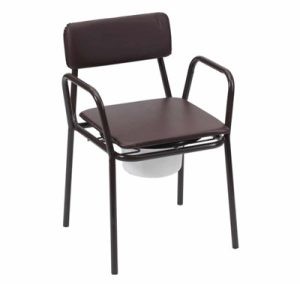Neurodiversity information for parents and young people
This guide is for patients who have been assessed as needing a static commode to improve independence in the home. It is also for the families, carers and professionals supporting you.

Maximum weight limit
165 kg (or 364 lbs, about 26 stone)
What a static commode is for
A static commode helps you:
- to use a toilet in your home when it is difficult to access a bathroom
- to use a toilet when you have reduced mobility.
Do not use a commode:
- you have not been assessed as needing one
- you are weak on one side or lean heavily to one side as the commode may tip over
- your home has uneven or weak flooring
- your arms or upper body are weak
- you do not have a wall or firm support to go behind the commode and stop it from tipping backwards.
How to set up the commode
When you first receive the commode, check that it is not damaged, all 4 leg clips are intact and the rubber feet are fitted correctly.
To ensure the commode is the correct height:
- Sit on the commode wearing your usual shoes or slippers. Another person will need to measure from the back of your knee to your heel when your foot is flat to the floor.
- Remove the padded seat and the bucket, take the clips out of all of the legs and adjust the height of the commode to the same height as the leg measurement to make sure that your knees are at a right angle when sitting on the commode. Replace the clips.
- Always make sure all 4 legs are the same height so the commode is stable, and then place the commode against a wall or firm back support to minimise the risk of it tipping backwards.
Contacts
Contact your borough to collect your kitchen trolley or request a repair.
- Kingston - Medequip
020 8154 2922 - Merton - Uniquis
020 8664 8860 - Richmond - NRS
0300 100 0253 - Surrey - Millbrook
0330 124 1247